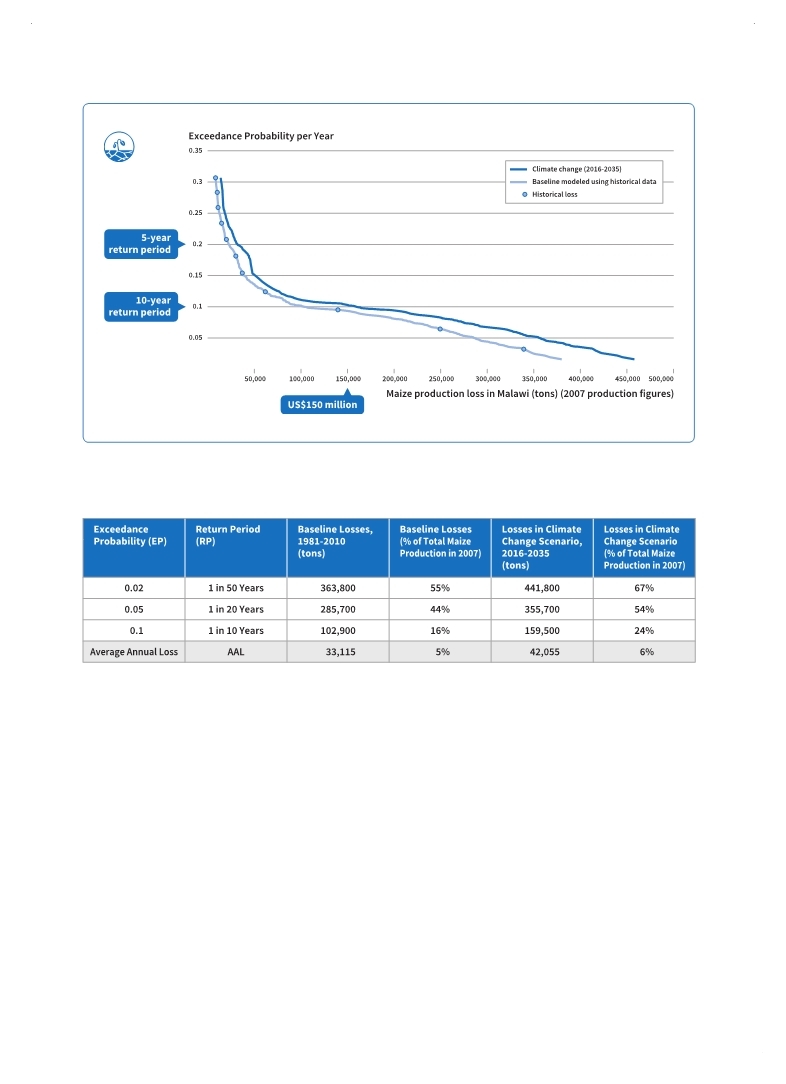 |
Global Assessment Report on Disaster Risk Reduction 2015
Making development sustainable: The future of disaster risk management |
 |
Global Assessment Report on Disaster Risk Reduction 2015
Making development sustainable: The future of disaster risk management |
|
|

86
Part I - Chapter 3
Figure 3.36 Malawi maize production loss in tons with respect to 2007 countrywide production of maize
(Source:
 Jayanthi, 2014 Jayanthi, 2014 Jayanthi, Harikishan. 2014,Assessing the agricultural drought risks for principal rainfed crops due to changing climate scenarios using satellite estimated rainfall in Africa, Background Paper prepared for the 2015 Global Assessment Report on Disaster Risk Reduction.. Jayanthi, Harikishan. 2014,Assessing the agricultural drought risks for principal rainfed crops due to changing climate scenarios using satellite estimated rainfall in Africa, Background Paper prepared for the 2015 Global Assessment Report on Disaster Risk Reduction.. Click here to view this GAR paper. Table 3.3 Estimated maize production losses in Malawi with and without climate change
(Source:
 Jayanthi, 2014 Jayanthi, 2014 Jayanthi, Harikishan. 2014,Assessing the agricultural drought risks for principal rainfed crops due to changing climate scenarios using satellite estimated rainfall in Africa, Background Paper prepared for the 2015 Global Assessment Report on Disaster Risk Reduction.. Jayanthi, Harikishan. 2014,Assessing the agricultural drought risks for principal rainfed crops due to changing climate scenarios using satellite estimated rainfall in Africa, Background Paper prepared for the 2015 Global Assessment Report on Disaster Risk Reduction.. Click here to view this GAR paper. For example, losses in maize production from a 1-in-25-year drought in Malawi are estimated to be 23 per cent higher in 2016-2035 than in 19812010 based on near-future climate change scenarios (Figure 3.36).
Climate change could result in significant additional losses in maize production (Table 3.3) and potentially push countries like Malawi over a resilience threshold in terms of the national economy as well as poverty.
In contrast, climate change could have a positive impact on maize and millet yields in Kenya and Niger, respectively (
 Jayanthi, 2014 Jayanthi, 2014 Jayanthi, Harikishan. 2014,Assessing the agricultural drought risks for principal rainfed crops due to changing climate scenarios using satellite estimated rainfall in Africa, Background Paper prepared for the 2015 Global Assessment Report on Disaster Risk Reduction.. Jayanthi, Harikishan. 2014,Assessing the agricultural drought risks for principal rainfed crops due to changing climate scenarios using satellite estimated rainfall in Africa, Background Paper prepared for the 2015 Global Assessment Report on Disaster Risk Reduction.. Click here to view this GAR paper. The agricultural drought risk to maize in the Kenya Rift Valley, for example, is forecast to decline in the near future (2016-2035) due to the impact of climate change. In the climate change scenario, PML100 (probable maximum loss corresponding to a 1-in-100-year drought) would fall
|
 
Page 1Page 10Page 20Page 30Page 40Page 50Page 60Page 70Page 76Page 77Page 78Page 79Page 80Page 81Page 82Page 83Page 84Page 85Page 86Page 87->Page 88Page 89Page 90Page 91Page 92Page 93Page 94Page 95Page 96Page 97Page 98Page 99Page 100Page 110Page 120Page 130Page 140Page 150Page 160Page 170Page 180Page 190Page 200Page 210Page 220Page 230Page 240Page 250Page 260Page 270Page 280Page 290Page 300Page 310
|
|
 
|
 
|
